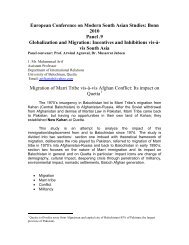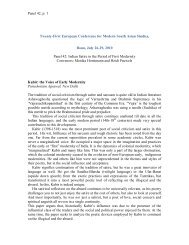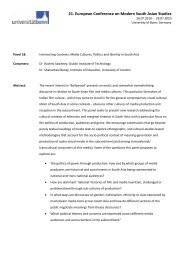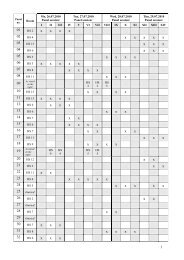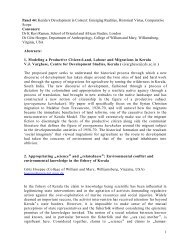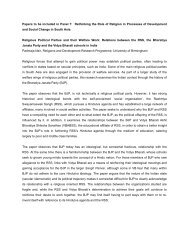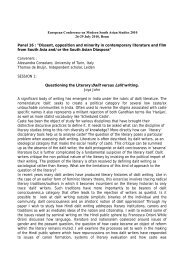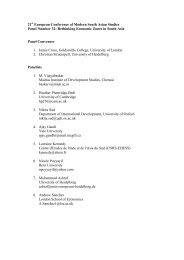Panel 13
Panel 13
Panel 13
You also want an ePaper? Increase the reach of your titles
YUMPU automatically turns print PDFs into web optimized ePapers that Google loves.
Religion and ‘Otherness’ in Bollywood Film<br />
Dr. Diana Dimitrova<br />
Michigan State University<br />
East Lansing, Michigan, USA<br />
This paper will explore the representation of the notion of ‘otherness’ in Bollywood film.<br />
I will focus on the interpretation of the West and of the religious ‘other’ in film as well as<br />
on issues of diaspora and globalization. Some of the most recent Bollywood films that I<br />
will discuss are: Lagan (The Rent on Land), Dil cahta hai (The Heart Wants), and Ham<br />
Dil De Cuke sanam (I Have Already Given My Heart Away), Dilwale Dulhane Le<br />
Jayenge (The Bridegroom will Take away the Bride) and Kuch kuch hota hai (Something<br />
Happens). It is characteristic of the films that they deal with aspects of modernity,<br />
westernization and globalization in order to assert nationalistic Hindu identity that is<br />
different, “other,” and often traditional and conservative. The paper will examine the<br />
ideological implications of the representation of religion and ‘otherness’ and will also<br />
address questions of orientalism, diaspora and globalization.<br />
Imagining the Powerful ‘Other’: Representations of Razia Sultan<br />
Dr. Urvi Mukhopadhyay,<br />
West Bengal State University,<br />
West Bengal, India<br />
Razia bin Iltutmish (1236-40 AD) was perhaps the first woman in the Islamic world who<br />
exercised her political power from not behind the scenes, but actually as a ruler. Though<br />
the medieval sources have scarcely referred to this unusual phenomenon, an interest<br />
about this atypical ruler is quite rampant in the Orientalist writings since days of the<br />
colonial period. Romantic tales about Razia and her ‘fatal’ relationship with her ‘black’<br />
‘slave’ became a staple for historical romances as early as in 1836 where the focus was<br />
on ‘tragic’ tales of medieval lives under the oppressive conditions of ‘despotic’<br />
governance and ‘bizarre customs’. The image of Razia became more intriguing as it<br />
could generate the seductive attraction of the oriental pleasures by portraying a woman at<br />
the centre of the courtly intrigues. This imagery drew a striking resemblance with widely<br />
portrayed image of another oriental female ruler Cleopatra, whose representation became<br />
the reservoir of polemical ‘other’ of the occidental male self in popular literature and<br />
films. The feminine image of Razia, however, stirred a more complex emotion during the<br />
nationalist movement, when the woman with power to rise against the ‘demonic’ rule of<br />
the foreign power was evoked to uphold the nationalist self-esteem. At least three<br />
versions of Razia’s reign were made on screen during three different historical periods:<br />
1924, 1961 and 1983 respectively.<br />
This paper would like to trace the popular representations of Razia, especially on screen<br />
by which the politics of representation of the controversial stereotypes such as ‘oriental<br />
despot’, ‘female ruler’ and ‘Islamic woman’ could be re-invoked. The focus will be on<br />
three different films made on Razia named Razia Begum (1924), Razia Sultan (1961) and<br />
6



